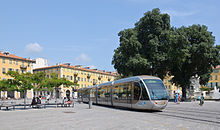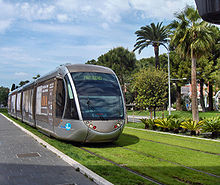- Nice tramway
-
This article is about the new tramway of Nice, for the old network, see Tramway de Nice et du Littoral
Tramway de Nice 
Info Locale Nice, Provence-Alpes-Côte d'Azur Transit type Tram Number of lines 1 Number of stations 21 Daily ridership 70,000 (2010) Operation Began operation 2007 Operator(s) ST2N Technical Track gauge 1,435 mm (4 ft 8 1⁄2 in) System map Tramway de Nice Line 1 Legend
Las Planas 
Comte de Falicon 
Le Ray 
Gorbella 






Valrose Université 
Borriglione 
Libération (For Nice CP station  )
)
Marseille-Ventimille Railway line 
Gare Thiers (For Nice Ville station  )
)
Jean Médecin 
Points allowing half-line operation if place Masséna is closed 
Masséna 

Unelectrified section (crossing of place Masséna) 

Opéra-Vieille Ville 
Points allowing half-line operation if place Masséna is closed 
Cathédrale-Vieille Ville 

Unelectrified section (crossing of place Garibaldi) 

Garibaldi 
Acropolis 
Palais des Expositions 
Marseille-Ventimille Railway line 
Vauban 
St-Jean d'Angely Université 






St-Roch 
Virgile Barel 
St-Charles 
Pont Michel The Nice tramway is a tram system of 8.7-km rail, currently composed of one line, and operated by the Société nouvelle des transports de l'agglomération niçoise, under the trade name of Lignes d'azur. Opened on 24 November 2007, it replaces the bus lines 1, 2, 5 and 18. At its start-up, twenty Alstom Citadis trains were put into circulation, providing a frequency of seven minutes.
Since its inception, the number of passengers has increased from 70,000 per day in 2008 to 90,000 per day in 2011. The frequency of trams gradually increase from seven to five minutes, even four minutes by 2011.
Given the success of the T1 line, mayor of Nice Christian Estrosi decided to create two other lines which are planned for 2015. Line 2 should serve the Nice airport to the west through the construction of a multimodal center and the Port of Nice to the east. As for the line 3, it will cross the valley of the Var. In addition, the Metropolitan Nice Riviera decided to extend the line to a neighborhood of Shepherd.
Contents
History
The former tram
Main article: Tramway de Nice et du LittoralThe first tramway in Nice, the Tramway de Nice et du Littoral, appeared in 1900, and was followed by a departmental network in 1906. The entire network was electrified in 1910. In the 1920s, the network had 11 lines, some of which were partially used to goods transport. However, the tram was criticized and the bus was was preferred in 1927. The last tramway in Nice disappeared on 10 January 1953.
The current tram
As many other French cities, Nice has major traffic problems, including the fact that most economic activities are concentrated in the center. To overcome these problems, studies on the implementation of a transit in dedicated lanes were conducted in 1987. The city of Nice began to establish a line of bus in 1997, and launched the consultation on the implementation of a tram line in 1998.
The tram was chosen because it appeared to more reliable than the bus, since it is not subject to the vagaries of traffic and is less expensive than a subway line. The tram was declared a public utility in 2003 and development works began the same year but were not fully completed by early December 2007, while the commissioning service was conducted on 24 November 2007, after several weeks of technical trials.
In the months following the launch of the tram, there were between 65,000 and 70,000 passengers daily;[1] the number rose to 90,000 in January 2011.[2]
Network
The Nice tramway was designed to serve most of the population of Nice. As the city is situated on hilly ground by the sea, the line was drawn as a U shape, passing through the city centre.
There is currently only one line, served by two termini: Las Planas and Pont Michel. A second line, which would connect the city centre with the airport, is under discussion.
Las Planas terminus
The tram depot is situated at the northwestern terminus of the line in the neighbourhood of Le Rouret, where the Count of Falicon and the Marquis of Rouret once owned large villas and many farms dotted the land.
Above the tram terminus sport and cultural centres have been built. The plaza in front of the station has been raised and planted, with a fountain of water jets installed.
Fontaine du Temple
The Fontaine du Temple neighbourhood where the Comte de Falicon tram stop is built has been remodelled for the arrival of the tramway. The plaza has been repaved and will host an outdoor market.
Tram and art
Art works are used throughout the line, including sculptures of figures by Jaume Plensa, on the top of pylons on the Place Massena. Michel Redolfi designed the sound system. Artists Benjamin Vautier said "Ben" (who wrote all the name of the stations), the Mado la Niçoise, Michael Lonsdale, etc, make voice announcements inside the tram. Sounds and voices are different depending on the hours, seasons, etc. The thirteen artists selected to accompany the tramway by developing the urban area are:[3]
- Ben (Benjamin Vautier);
- Michael Craig Martin;
- Gunda Förster;
- Yann Kersalé;
- Ange Leccia;
- Stéphane Magnin;
- Maurizio Nannucci;
- Jean-Michel Othoniel;
- Pascal Pinaud;
- Jaume Plensa;
- Emmanuel Saulnier;
- Pierre di Sciullo;
- Sarkis Zabunyan;
- Jacques Vieille.
Rolling stock
The cars of the Nice tramway are unique and have been designed to blend in with the Niçois architecture. They are based on Alstom Citadis family of tramcars and were built near La Rochelle, Poitou-Charentes. A standard 5 car tram measures 35 m but extra carriages may be added, bringing the length to 45 m. The tram is 2.65 m wide and may carry 200 passengers at 18 km/h compared to 11 km/h by bus. It uses the 1,435 mm (4 ft 8 1⁄2 in) standard gauge.
Power supply
Nice tramway was originally to use the ground-level power supply third rail system as used by Bordeaux tramway. However, this was abandoned in favor of the more conventional overhead power supply cables providing 750V DC, except when the tram crosses the Place Masséna and Garibaldi, when it lowers its pantograph and relies on its onboard nickel metal hydride batteries to cross these large open spaces, where overhead wires would be an eyesore.
See also
- Trams in France
- List of town tramway systems in France
References
- ^ Beal, Sylvie (30 May 2008). "Nice - La ligne 2 du tram : tout de suite, plus tard, jamais ?" (in French). Nice-Matin (Nice: Nice Matin Group). http://www.nice.maville.com/actu/actudet_--Nice-La-ligne-2-du-tram-tout-de-suite-plus-tard-jamais-_loc-638803_actu.Htm. Retrieved 14 July 2011..
- ^ Casals, Sophie (20 January 2011). "Bus: ça roule, mais..." (in French). Nice-Matin (Nice: Nice Matin Group). http://www.nicematin.com/article/nice/bus-ca-roule-mais. Retrieved 14 July 2011.
- ^ "L'art dans la ville, avec le tramway Nice Côte d'Azur" (in French) (pdf). agglo-nice.fr. http://www.agglo-nice.fr/presse/medias/20071126_canca.pdf. Retrieved 14 July 2011.
External links
 Media related to Nice tramway at Wikimedia Commons
Media related to Nice tramway at Wikimedia Commons- (French) Official website
- (French) ST2N official website
- (English) The Nice tramway
Urban guided transit systems in France Métros PresentTramways PresentPlannedFormerAvranches · Bordeaux · Cannes · Caen · Grenoble · Deauville · Fontainebleau · Le Havre · Lyon · Nantes · Nice et Littoral · Paris · Rouen · Saint-Romain-de-Colbosc · Strasbourg · Valenciennes · VersaillesGuided buses PresentPlannedDouai · ParisUrban funiculars PresentFormerBesançonUrban cable cars PresentGrenoblePeople movers PresentSee also: Transport in France, List of railways in France, Trams in France, and Railways in FranceCategories:- Transport in Nice
- Tram transport in France
Wikimedia Foundation. 2010.



